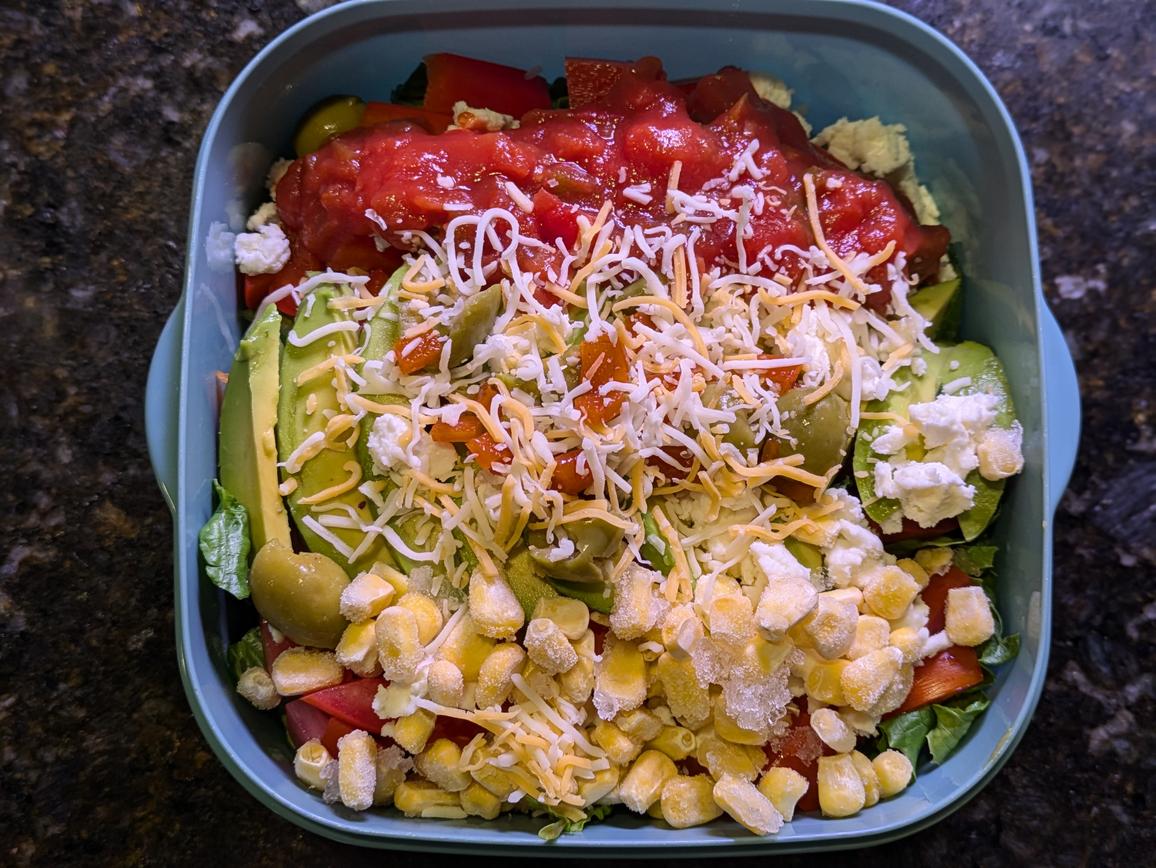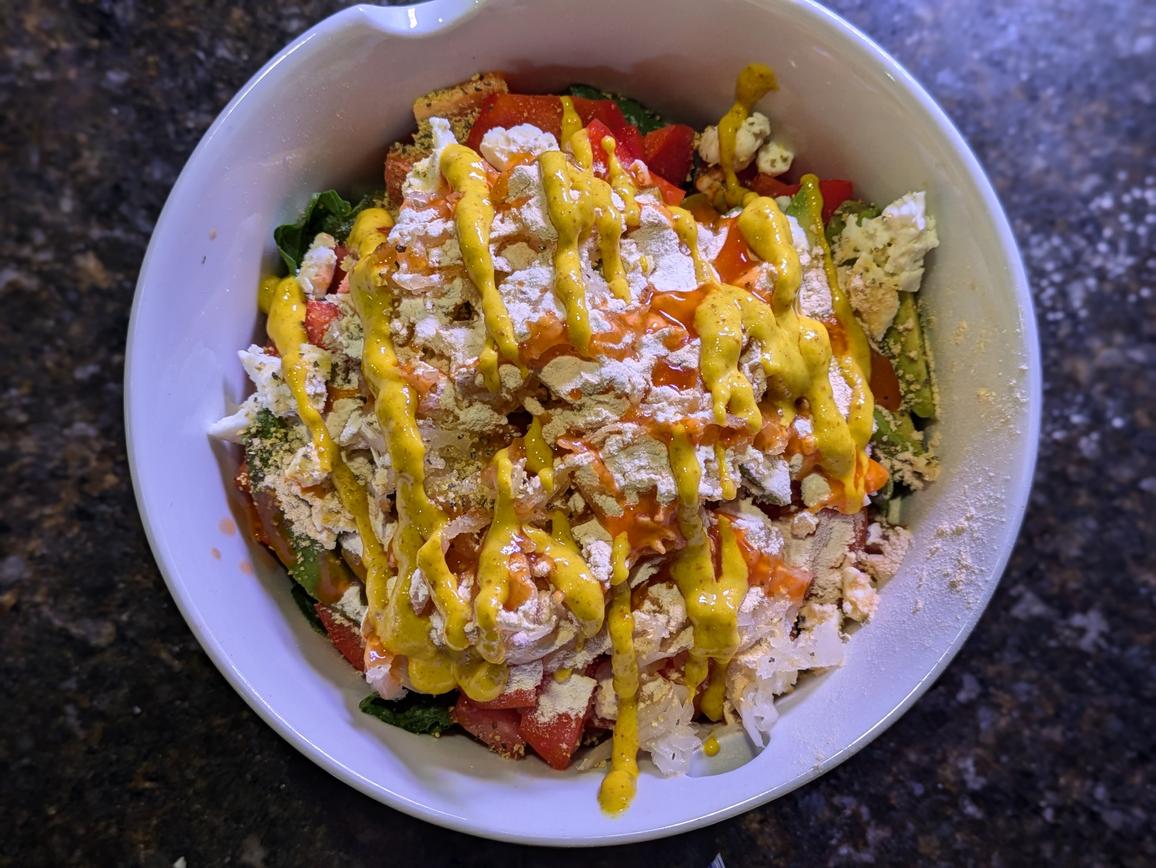
Introduction
Salad isn’t boring; you’re just doing it wrong. If you think you don’t like salads, then you’ve obviously just never had a good one. If you had nothing but a piece of American cheese and ketchup between 2 slices of white bread, you may conclude that sandwiches are boring too. That’s what salads are. They can be a sad bowl of soggy iceberg lettuce with nothing but a bottled dressing and a couple of tomatoes, or they can be a delicious, filling, and nutritious meal that’s a joy to eat.
The name of the game with a salad is to eat as many different foods of varying taste and texture for a delicious heterogenous experience. I’m going to break down the important steps in building your ultimate salad, while also showing photos of some of the amazing bowls I’ve made recently.
Table of Contents
- Equipment
- Base
- Raw Vegetables
- Cooked Vegetables
- Pickled Vegetables
- Cheese
- Spices
- Protein
- Fats
- Carbs
- Dressing

Equipment
There’s just a few simple tools you need to make a great salad. Obviously, you need a knife and cutting board, but what’s also essential is a good salad spinner. Here is a link to the salad spinner I have. A salad spinner is crucial, because it dries your vegetables after washing them. Without properly drying your veggies, your salad will end up soggy and gross, and your spices and dressing will not be able to properly stick to your food.

Base
The foundation of your salad is your base. This is some type of dark leafy green vegetable. I typically reach for Romaine lettuce, but sometimes I’ll mix it up with spinach, kale, or arugula as well. Either choose just one, or blend together multiple leaves to serve as the base of your salad. Don’t over-lettuce your salad either; you should aim for a ratio of about 50% of the bowl being your base. Any more, and it feels like too much leafy green (at least in my opinion). Just thinly slice your dark leafy greens, wash, spin, and drain.

Raw Vegetables
A good salad is a combination of a base green and a multitude of vegetables. My go-to vegetables for nearly every salad are tomatoes and bell peppers. Simply wash them, cut into a small or medium dice, and add to the bowl. Other great vegetables include onion, radishes, shredded carrots, and cucumber.

Cooked Vegetables
Yes, a salad can have cooked vegetables as well. Try replacing a raw bell pepper with some roasted peppers. Or crack open a can of artichokes and chop that into a salad. Roasted yellow squash, zucchini, and eggplant are other delicious options (like in my Grilled Eggplant and Chickpea Salad), or even some nice charred broccoli or cauliflower.

Pickled Vegetables
Pickled vegetables are great too! Try adding banana peppers, pickled red onions, or yes even pickles. Don’t knock it till you try it; the acidity and saltiness of the pickled vegetables pairs perfectly with everything else. My personal favorite is adding sauerkraut to my salad, but kimchi also works great too.

Cheese
Cheese levels up a salad to a whole new level; it’s delicious and adds some well needed fat. My personal favorite is easily crumbled feta, but blue cheese, gargonzola, and fresh mozzarella are also fantastic. Sometimes I’ll just shake some parmesean from the container onto a salad if I don’t have any other cheese on hand. Don’t add too much though; this is still suppossed to be a healthy salad, not a bowl of feta with some vegetables (sorry Phil’s Pizzeria Greek Salad).

Spices
This is easily the most overlooked part of a salad: dried spices. What I do is I make a big base in my salad spinner every few days consisting of lettuce, tomatoes, peppers, feta, and spices. I’ll then add my toppings, like protein, fat, carbs, pickled veggies, and dressing on top to each individual bowl. Every salad ends up being different, but the base itself tastes good on it’s own without adding anything additional to this. This is the role of the spices. I personally just dump on lemon pepper, garlic powder, onion powder, and black pepper. You should aim to add enough spices to the base where you feel like you don’t need any dressing, but would still like to add a little more.

Protein
In my opinion, a salad can’t be a meal unless it has some sort of protein. Otherwise, it’s just a side salad that won’t keep you full. Protein is the most satiating macro nutrient, as well as being delicious. Without it, you’ll just end up hungry. I don’t normally make any meat fresh for my salads; instead, just taking whatever leftovers I have in the fridge to top my bowl. Great meats to put on salad include chicken breast or thighs, ground turkey or beef, salmon, tilapia, or canned tuna. The following recipes work great as a protein topping to your salad:
- Roasted Italian Chicken Breast and Acorn Squash
- Indian Chicken and Sweet Potatoes
- Balsamic Caprese Chicken with Roasted Artichokes
- BBQ Pulled Chicken and Coleslaw
- Marinated Chicken with Air Fried Plantains
- Dutch Oven Bolognese Sauce
- Sauteed Taco Meat and Fajita Veggies
- Classic BBQ Meatloaf and Lemon Roasted Broccoli
- Chopped Burger Bowl with Sweet Potatoes
- Nam Sod (Thai Pork Salad)
- Massive Restaurant Salad for 1
- Simply Baked Salmon and Crunchy Salad
- Air Fried Tilapia from Frozen
In the absense of meat or fish, I like to either crumble on some Dijon Protein Crumbles, or drink a Simple Protein Shake on the side.

Fats
I’ve just discussed cheese, but other healthy fat sources are essential. Most of the vitamins in the raw vegetables are fat soluble, meainging that without an adequate amount of fat in the salad, you’re really not getting much out of it. The traditional fat added to salad is extra virgin olive oil. However, I prefer not to just dump a ton of oil on my salad, as it contributes very little to the taste and results in a ton of empty calories. Instead, I like to add some combination of olives, avocado, or chopped nuts (like almonds or pistachios) or seeds (like pumpkin seed and sunflower seed).

Carbs
Salads are typically though of as a low carb meal; and I think it should be. However, having some carb source is great for helping you feel full and diversifying your nutrient intake. The easiest and best carb source for a salad (in my opinion) is beans. Whatever you have on hand will work: chickpeas, black peans, kidney, pinto, etc. Just crack open the can, drain and rinse, and dump onto the salad. To make it even better, you can cook the beans; Slow Cooker Black Beans and Refried Pinto Beans make shockingly great toppings, adding good carbs, protein, fiber, and iron. Other great carb sources for salad include roasted sweet potatoes (see my Indian Chicken and Sweet Potatoes), corn, or diced fruit (kiwi, strawberries, apples, pears, blueberries, etc.). Classic Rice and Beans is also a very easy and good carb source for your bowls.

Dressing
Last, but certainly not least, we have the dressing. You may have noticed from my photos that most of my salads have hot sauce and dijon mustard. This combination is my preferred easy “dressing”, as they’re both just flavored vinegars. Stay away from bottled dressing. Not only are they probably bad for you, contianing high amounts of sugar, fat, and salt, but they also don’t taste very good. Don’t be afraid to put things that aren’t traditionally “dressing” onto a salad. Great examples of homemade dressings include:
- Olivcado Salad Dressing
- Holy Guacamole
- Five Minute Salsa (No Garlic/Onion)
- Tomato Burger Spread
- Peanut Chili Salad Dressing
- Unsweetened BBQ Sauce
- Creamy Pesto Dip
- Or any of my varieties of hummus
I also have more standard dressing recipes in the following meals. Use them for these dishes, or use them on a regular salad as well:
- Mediterranean 3 Bean Salad
- Grilled Eggplant and Chickpea Salad
- Mediterranean Sweet Potato Salad
- Mediterranean Pasta Salad

Sources